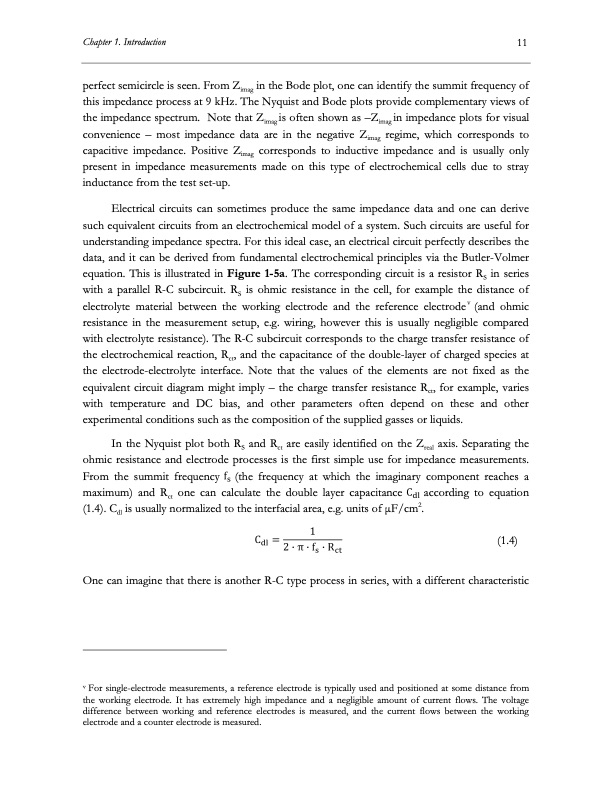
PDF Publication Title:
Text from PDF Page: 032
Chapter 1. Introduction 11 perfect semicircle is seen. From Zimag in the Bode plot, one can identify the summit frequency of this impedance process at 9 kHz. The Nyquist and Bode plots provide complementary views of the impedance spectrum. Note that Zimag is often shown as –Zimag in impedance plots for visual convenience – most impedance data are in the negative Zimag regime, which corresponds to capacitive impedance. Positive Zimag corresponds to inductive impedance and is usually only present in impedance measurements made on this type of electrochemical cells due to stray inductance from the test set-up. Electrical circuits can sometimes produce the same impedance data and one can derive such equivalent circuits from an electrochemical model of a system. Such circuits are useful for understanding impedance spectra. For this ideal case, an electrical circuit perfectly describes the data, and it can be derived from fundamental electrochemical principles via the Butler-Volmer equation. This is illustrated in Figure 1-5a. The corresponding circuit is a resistor RS in series with a parallel R-C subcircuit. RS is ohmic resistance in the cell, for example the distance of electrolyte material between the working electrode and the reference electrodev (and ohmic resistance in the measurement setup, e.g. wiring, however this is usually negligible compared with electrolyte resistance). The R-C subcircuit corresponds to the charge transfer resistance of the electrochemical reaction, Rct, and the capacitance of the double-layer of charged species at the electrode-electrolyte interface. Note that the values of the elements are not fixed as the equivalent circuit diagram might imply – the charge transfer resistance Rct, for example, varies with temperature and DC bias, and other parameters often depend on these and other experimental conditions such as the composition of the supplied gasses or liquids. In the Nyquist plot both RS and Rct are easily identified on the Zreal axis. Separating the ohmic resistance and electrode processes is the first simple use for impedance measurements. From the summit frequency (the frequency at which the imaginary component reaches a maximum) and Rct one can calculate the double layer capacitance according to equation (1.4). Cdl is usually normalized to the interfacial area, e.g. units of μF/cm2. (1.4) One can imagine that there is another R-C type process in series, with a different characteristic v For single-electrode measurements, a reference electrode is typically used and positioned at some distance from the working electrode. It has extremely high impedance and a negligible amount of current flows. The voltage difference between working and reference electrodes is measured, and the current flows between the working electrode and a counter electrode is measured.PDF Image | Electrolysis of CO2 and H2O

PDF Search Title:
Electrolysis of CO2 and H2OOriginal File Name Searched:
co2-hso-fuels.pdfDIY PDF Search: Google It | Yahoo | Bing
NFT (Non Fungible Token): Buy our tech, design, development or system NFT and become part of our tech NFT network... More Info
IT XR Project Redstone NFT Available for Sale: NFT for high tech turbine design with one part 3D printed counter-rotating energy turbine. Be part of the future with this NFT. Can be bought and sold but only one design NFT exists. Royalties go to the developer (Infinity) to keep enhancing design and applications... More Info
Infinity Turbine IT XR Project Redstone Design: NFT for sale... NFT for high tech turbine design with one part 3D printed counter-rotating energy turbine. Includes all rights to this turbine design, including license for Fluid Handling Block I and II for the turbine assembly and housing. The NFT includes the blueprints (cad/cam), revenue streams, and all future development of the IT XR Project Redstone... More Info
Infinity Turbine ROT Radial Outflow Turbine 24 Design and Worldwide Rights: NFT for sale... NFT for the ROT 24 energy turbine. Be part of the future with this NFT. This design can be bought and sold but only one design NFT exists. You may manufacture the unit, or get the revenues from its sale from Infinity Turbine. Royalties go to the developer (Infinity) to keep enhancing design and applications... More Info
Infinity Supercritical CO2 10 Liter Extractor Design and Worldwide Rights: The Infinity Supercritical 10L CO2 extractor is for botanical oil extraction, which is rich in terpenes and can produce shelf ready full spectrum oil. With over 5 years of development, this industry leader mature extractor machine has been sold since 2015 and is part of many profitable businesses. The process can also be used for electrowinning, e-waste recycling, and lithium battery recycling, gold mining electronic wastes, precious metals. CO2 can also be used in a reverse fuel cell with nafion to make a gas-to-liquids fuel, such as methanol, ethanol and butanol or ethylene. Supercritical CO2 has also been used for treating nafion to make it more effective catalyst. This NFT is for the purchase of worldwide rights which includes the design. More Info
NFT (Non Fungible Token): Buy our tech, design, development or system NFT and become part of our tech NFT network... More Info
Infinity Turbine Products: Special for this month, any plans are $10,000 for complete Cad/Cam blueprints. License is for one build. Try before you buy a production license. May pay by Bitcoin or other Crypto. Products Page... More Info
| CONTACT TEL: 608-238-6001 Email: greg@infinityturbine.com | RSS | AMP |